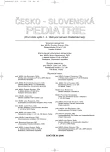-
Medical journals
- Career
The Therapy of the Deep Cartilage Defects in the Knee Joint by the Transplantation of Cultivated Autologous Chondrocytes in Children and Adolescents
Authors: M. Handl 1; T. Trč 1; M. Hanus 1; E. Šťastný 1; M. Fricová-Poulová 2; J. Neuwirth 2; J. Adler 3; D. Havranová 3; F. Varga 4
Authors‘ workplace: Ortopedická klinika dětí a dospělých 2. LF UK, FN Motol, Praha přednosta doc. MUDr. T. Trč, CSc. 1; Klinika zobrazovacích metod 2. LF UK, FN Motol, Praha přednosta prof. MUDr. J. Neuwirth, CSc. 2; Tkáňová banka, FN Brno-Bohunice přednostka MUDr. D. Havranová 3; Oddělení biofyziky 2. LF UK, FN Motol, Praha přednosta doc. RNDr. E. Amler, CSc. 4
Published in: Čes-slov Pediat 2006; 61 (7-8): 413-423.
Category: Original Papers
Overview
Introduction:
The study was focused on the treatment of the deep cartilage defects in the knee joint in children and adolescents. The method of cultivated autologous chondrocyte transplantation in the form of a solid chondrograft was used in all cases.Material and methods:
Fresh injuries of the knee joint or sequelae of its intraarticular derangement resulting in a deep focal cartilage defect were surgical indications for the cartilage transplantation. The defects were classified preoperatively according to the Bessette and Hunter score and intraoperatively during arthroscopy according to the Outerbridge score. In the case of a positive finding, a full cartilage sample was harvested from the non-weight-bearing zone of the trochlea femoris. In the Tissue Bank, a solid chondrograft was formed from cultivated chondrocytes over a period of 28 to 42 days and then prepared for the transplantation. Tissucol tissue glue was used for graft fixation.Results:
From July 2003 to November 2005 the 12 patients (8 males and 4 females) were treated by this method. The age range was 10 to 18 years, with a mean age of 15.2 years. The follow-up periods ranged from 7 to 20 months with an average of 12.2 months. The magnetic resonance imaging (MRI) scans were evaluated before the surgery and after that at intervals of 2 w, 2–6 m and 1 year. The clinical results were evaluated according to the Meyers, Tegner and Lysholm-Gillquist scores.Conclusions:
The clinical function of the knee joint showed significant improvement in the comparison between initial and final follow-up terms and also results comparing to the contralateral non-injured knee were improved. MRI evaluation showed a good integration of chondrografts.Key words:
knee point, children and adolescent, injury, chondrocyte, cartilage transplantation
Labels
Neonatology Paediatrics General practitioner for children and adolescents
Article was published inCzech-Slovak Pediatrics

2006 Issue 7-8-
All articles in this issue
- Ten Years of Experience with Drug Therapy of Familial Hypercholesterolemia in Children and Adolescents
- The Therapy of the Deep Cartilage Defects in the Knee Joint by the Transplantation of Cultivated Autologous Chondrocytes in Children and Adolescents
- Late Diagnostics and Therapy of Pyloric Membrane
- Alobar Holoprosencephaly – A Case Report of Two Cases
- Indication and Principles of Molecular-Genetic Investigation
- Present Knowledge about Bird Influenza and Importance for Human Population
- Cardiopulmonary Resuscitation – Novel Recommended Procedures
- Czech-Slovak Pediatrics
- Journal archive
- Current issue
- Online only
- About the journal
Most read in this issue- Alobar Holoprosencephaly – A Case Report of Two Cases
- Indication and Principles of Molecular-Genetic Investigation
- The Therapy of the Deep Cartilage Defects in the Knee Joint by the Transplantation of Cultivated Autologous Chondrocytes in Children and Adolescents
- Cardiopulmonary Resuscitation – Novel Recommended Procedures
Login#ADS_BOTTOM_SCRIPTS#Forgotten passwordEnter the email address that you registered with. We will send you instructions on how to set a new password.
- Career

